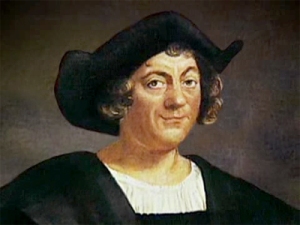
Posthumous portrait of Christopher Columbus by Sebastiano del Piombo, 1519. There are no known authentic portraits of Columbus.
On the evening of August 3, 1492, Christopher Columbus departed from Palos de la Frontera, Spain with three ships: the Santa María, and two smaller caravels, the Pinta and the Santa Clara, nicknamed the Niña.
Columbus first sailed to the Canary Islands, which belonged to Castile, where he restocked the provisions and made repairs.
After stopping over in Gran Canaria, he departed from San Sebastián de La Gomera on September 6, 1492.
They sailed west into the unknown ocean until a lookout on the Pinta, Rodrigo de Triana (also known as Juan Rodríguez Bermeo), spotted land about 2:00 on the morning of October 12th, and immediately alerted the rest of the crew with a shout.
Thereupon, the captain of the Pinta, Martín Alonso Pinzón, verified the discovery and alerted Columbus by firing a lombard.
Columbus called the island (in what is now The Bahamas) San Salvador; the natives called it Guanahani.
Exactly which island in the Bahamas this corresponds to is still unresolved.
The indigenous people he encountered, the Lucayan, Taíno, or Arawak, were peaceful and friendly. Noting their gold ear ornaments, Columbus took some of the Arawaks prisoner and insisted that they guide him to the source of the gold.
Columbus then explored the northeast coast of Cuba, where he landed on October 28th.
On November 22nd, Martín Alonso Pinzón took the Pinta on an unauthorized expedition in search of an island called “Babeque” or “Baneque”, which the natives had told him was rich in gold.
Columbus, for his part, continued to the northern coast of Hispaniola, where he landed on December 5th.
There, the Santa María ran aground on Christmas Day 1492 and had to be abandoned. Columbus was received by the native cacique Guacanagari, who gave him permission to leave some of his men behind.
Columbus left 39 men, including Luis de Torres, the Converso interpreter, who spoke Hebrew and Arabic, and founded the settlement of La Navidad at the site of present-day Môle-Saint-Nicolas, Haiti.
Columbus took more natives prisoner and continued his exploration.
He kept sailing along the northern coast of Hispaniola with a single ship, until he encountered Pinzón and the Pinta on January 6, 1493.
On January 13, 1493, Columbus made his last stop of this voyage in the New World. He landed on the Samaná Peninsula, where he met the hostile Ciguayos who presented him with his only violent resistance during his first voyage to the Americas.
The Ciguayos had refused to trade the amount of bows and arrows that Columbus desired; in the ensuing violence two were stabbed to death.
Columbus kidnapped about 10 to 25 natives and headed home aboard the Niña.

1991 replica of the Niña
On the trip west, the crew had slept on the deck, but after seeing Natives sleeping in what we call hammocks, the crew adopted the use and slept in them on the trip back to Spain.
On February 14, 1493, a storm threatened to capsize the Niña, and, at Columbus’ instigation, he and the crew took a series of vows to perform certain acts, including pilgrimages, upon their safe return.
Columbus then decided to change course and make a detour to Lisbon.
Then on March 4, 1493, some 5 weeks after his departure, Christopher Columbus sailed into Lisbon, Portugal where he anchored next to the King’s harbor patrol ship.
After spending more than one week in Portugal, Columbus set sail for Spain. He crossed the bar of Saltes and entered the harbor of Palos de la Frontera on March 15, 1493.
Word of his discovery of new lands rapidly spread throughout Europe.
Now WE know em
